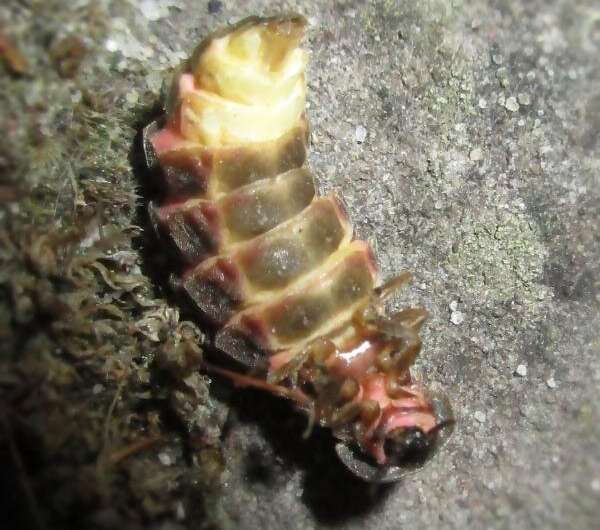This article has been reviewed according to Science X's editorial process and policies. Editors have highlighted the following attributes while ensuring the content's credibility:
fact-checked
peer-reviewed publication
trusted source
proofread
Brighter nights risk extinguishing glow-worm twinkle

The bright lights of big cities are wonders of the modern world; intended to help us work, stay safe and enjoy the world around us long after the sun has set. While artificial light has been great for increasing human productivity, some nocturnal animals, and even people, pay a price for this illumination. From increasing the amount of time that predators are active to disrupting migrations, light pollution affects many animals; but how do animals that use their own luminescence to lure food or attract mates fair against this new, brighter background?
Female common glow-worms (Lampyris noctiluca) emit a green glow from their abdomen to attract flying males, but they are unable to fly themselves to new locations to escape light pollution. Because of this, Estelle Moubarak, Sofia Fernandes, Alan Stewart and Jeremy Niven of the University of Sussex, UK, wondered how hard it is for male common glow-worms to find mates in an ever-brighter environment.
They have published their discovery explaining that white light makes it harder for male glow-worms to find glowing females, with potentially disastrous consequences for global glow-worm populations, in the Journal of Experimental Biology.
After collecting glow-worms at night from the South Downs, UK, Moubarak transported them back to the lab, before beginning the tricky task of transferring the male insects to a Y-shaped "maze" without exposing them to artificial light. The team placed the male glow-worms at the bottom of the Y, and a green LED, which mimicked a female's glow, at the top of one of the arms, toward which the male had to walk.
They then recorded whether the males could find the fake female, and how long it took. Then, the team switched on a white light above the maze, ranging from 25 Lux (25 times brighter than moonlight) to 145 Lux (equivalent to the light beneath a streetlamp). While all of the glow-worms found the LED in the dark, only 70% found the LED at the dimmest levels of white light, and just 21% of the insects found their potential mate in the brightest light.
Not only did the white light affect the glow-worm's ability to find a female, but it also caused them to take longer to reach the LED. In the dark, the worms took approximately 48 seconds to reach the female-mimicking LED; however, it took the same glow-worms approximately 60 seconds to reach the LED in the lowest white light levels.
Illuminating the maze also caused the male glow-worms to spend more time in the bottom part of the maze without moving towards a female. In the dark, the insects only spent about 32 seconds in the bottom of the Y, while they spent around 81 seconds in the bottom of the maze in the brightest conditions.
Moubarak suggests that male glow-worms were unable move towards the females when dazzled by white light because they cover their compound eyes with a head shield, which acts like a pair of sunglasses, reducing the amount of bright light they see. In fact, when the white light illuminated the area with the fake female LED, the glow-worms shaded their eyes for approximately 25% of the trial, compared to only about 0.5% of the time when the maze was in the dark.
"Keeping their eyes beneath their head shield shows male glow-worms trying to avoid exposure to the white light which suggests that they strongly dislike it," says Niven.
So, while our bright night-time world has helped give rise to our modern society, it has had a drastic impact on male glow-worms and their ability to find mates. If this trend holds true, meadows and heaths across Europe and Asia that have lit up with the twinkling of the female glow-worms for millions of years will fall dark.
More information: Artificial light impairs local attraction to females in male glow-worms, Journal of Experimental Biology (2023). DOI: 10.1242/jeb.245760. journals.biologists.com/jeb/ar … i/10.1242/jeb.245760
Journal information: Journal of Experimental Biology
Provided by The Company of Biologists




















